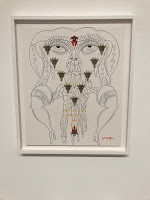Event #3: Hammer Museum
This past week, me and my teammates got a chance to visit the Hammer Museum in Westwood. The Hammer is known for accepting work all around the world, especially artists who are up and coming trying to make a name for themselves. One thing I had noticed while being at the museum is the amount of political and social issues that are addressed in the world through the art expressed. As an example, there was a giant red sign that had the words, "END WHiTE Supremacy".
One of the popular exhibits at the museum was the Jeanine Oleson exhibit. Jeanine Oleson is from New York and she creates art through photography, film, and sculpting. In the museum, Oleson's focus was using copper and linking the body, manual labor, and resources with art. The title of her project was "Conduct Matters". According to Oleson, "Mining late capitalism's alienating effects through material is extraction and labor...I'm making catalytic instruments and objects which alter the body's function in relationship to representation" (Oleson). She demonstrates this through her sculpture of a gramophone made out of copper.
Another exhibit at the museum consisted of the Judith Hopf exhibit. Judith Hopf is an artist from Germany who also uses sculptures from the ancient times to modern times. She would typically use materials such as bark, wood chips, and bricks which could be found in your own household's backyard. For example, there is a brick fist that is pointing towards the ceiling as well as a brick penguin sculpture. Hop's purpose behind these sculptures are to possibly address political issues as well as to please the aesthetic eye. One other side note of Hopf's brick sculptures is the fact they are all scattered amongst the floor and will come out of random areas to show that there are no boundaries for Hopf's sculptures.
Moreover, Oleson and Hopf's exhibits can be interpreted in several other ways also. Instead of each sculpture relating to political or social issues. Each sculpture could just be to appeal to the aesthetic eye. The deception of the sculptures give away the feeling that there must be an underlying message behind each sculpture. Many of times the first reaction of a viewer of art is to ask what the point of the art is. Essentially, Oleson and Hopf show that their is a point to contemporary art. The point of contemporary art is that there is no point and it is up to our interpretation to give the art meaning.
Resources:
"About Contemporary Art." The J Paul Getty Museum. N.p., n.d. Web. 04 June 2017.
"Hammer Museum." Wikipedia. Wikimedia Foundation, 27 May 2017. Web. 04 June 2017.
"Hammer Projects: Judith Hopf - Hammer Museum." The Hammer Museum. N.p., 02 June 2017. Web. 04 June 2017.
In Art, Film | September 28th, 2010 6 Comments. "John Waters: The Point of Contemporary Art." Open Culture. N.p., n.d. Web. 04 June 2017.
"Hammer Museum." Wikipedia. Wikimedia Foundation, 27 May 2017. Web. 04 June 2017.
"Hammer Projects: Judith Hopf - Hammer Museum." The Hammer Museum. N.p., 02 June 2017. Web. 04 June 2017.
In Art, Film | September 28th, 2010 6 Comments. "John Waters: The Point of Contemporary Art." Open Culture. N.p., n.d. Web. 04 June 2017.
"Jeanine Oleson - Hammer Museum." The Hammer Museum. N.p., 15 Sept. 2016. Web. 04 June 2017.
"TipArt." The Purpose Of Contemporary Art. N.p., n.d. Web. 04 June 2017.
"TipArt." The Purpose Of Contemporary Art. N.p., n.d. Web. 04 June 2017.






Comments
Post a Comment